A. PHONETICS
Task 1. Practise the following questions.
Thực hành các câu hỏi sau.
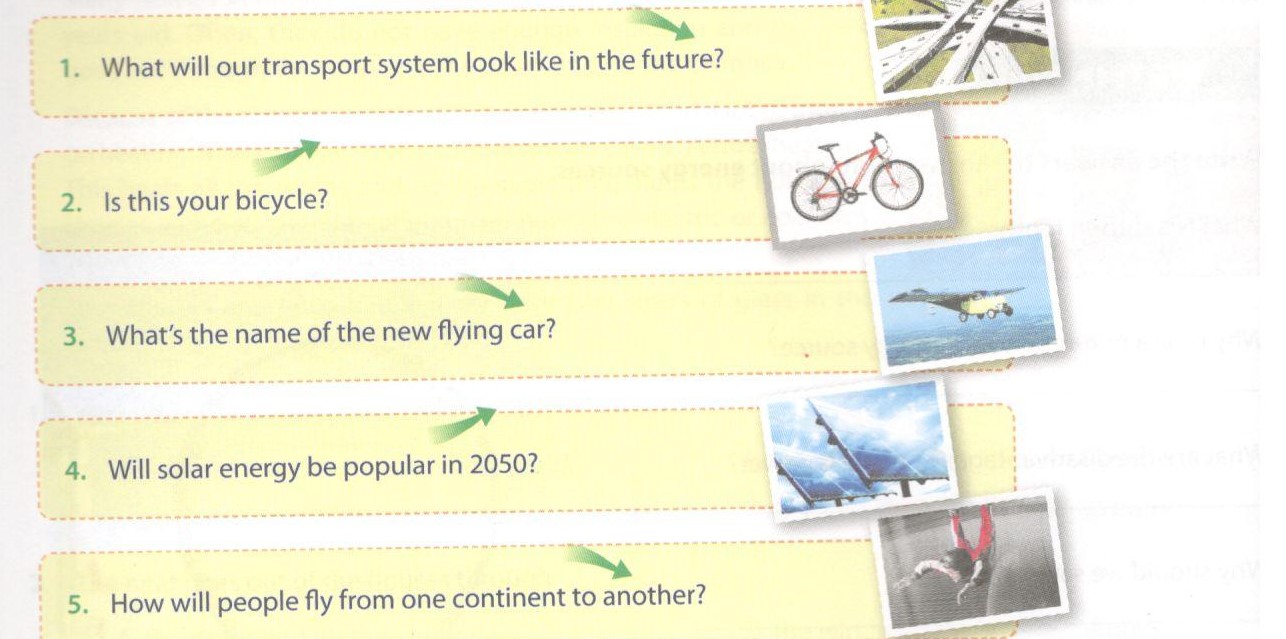
Lời giải chi tiết:
Tạm dịch:
1. Hệ thống vận tải trong tương lai sẽ như thế nào?
2. Đây là xe đạp của bạn à?
3. Tên của ô tô bay mới là gì?
4. Trong năm 2050 năng lượng mặt trời sẽ phổ biến chưa?
5. Con người sẽ bay từ một hành tinh sang hành tinh khác như thế nào?
Bài 2
Task 2. Put the questions into the correct category, then practise saying them.
Xếp mỗi câu hỏi sau vào đúng cột và luyện nói các câu hỏi đó.
1. What will you do when you grow up?
2. Do you want to be a millionaire?
3. How eco-friendly will cars be in the next 20 years?
4. Could you check the weather forecast for me? Will it rain tomorrow?
5. Which transport will be most popular in the future?
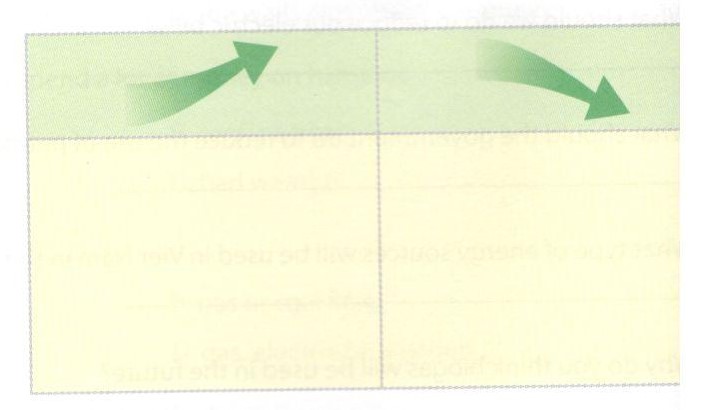
Lời giải chi tiết:
Key - Đáp án:

Bài 3
Task 3. Practise the following conversation.
Luyện tập đoạn hội thoại sau.
Phong: Have you got a bike, Tuan Anh?
Tuan Anh: Yes, I have. I bike to school every day.
Phong: Do you think it's the best way to move around?
Tuan Anh: Well... I don't know. Sometimes it's quite slow, especially when I'm already late. But it's eco-frie Do you have one, Phong?
Phong: Yes, but I wish I could use it more often. Do you think we need special lanes for bikes?
Tuan Anh: Yes, I think so. There're too many motorbikes. So how do you go to school?
Phong: I take the bus. I think we will soon have tubes in our city as well.
Lời giải chi tiết:
Phong: Tuấn Anh có xe đạp không?
Tuấn Anh: Vâng, tôi có. Tôi đạp xe đến trường mỗi ngày.
Phong: Bạn có nghĩ đó là cách tốt nhất để di chuyển?
Tuấn Anh: À ... Tôi không biết. Đôi khi nó khá chậm, đặc biệt là khi tôi đã muộn. Nhưng đó là bạn sinh thái. Bạn có chưa, Phong?
Phong: Vâng, nhưng tôi ước mình có thể sử dụng nó thường xuyên hơn. Bạn có nghĩ rằng chúng ta cần làn đường đặc biệt cho xe đạp không?
Tuấn Anh: Vâng, tôi nghĩ vậy. Có quá nhiều xe máy. Vậy bạn đi học bằng cách nào?
Phong: Tôi đi xe buýt. Tôi nghĩ chúng tôi cũng sẽ sớm có ống trong thành phố của chúng tôi.
B. VOCABULARY AND GRAMMAR
Task 1. Match the means of transport with their descriptions.
(Nối tên phương tiện với mô tả của nó.)
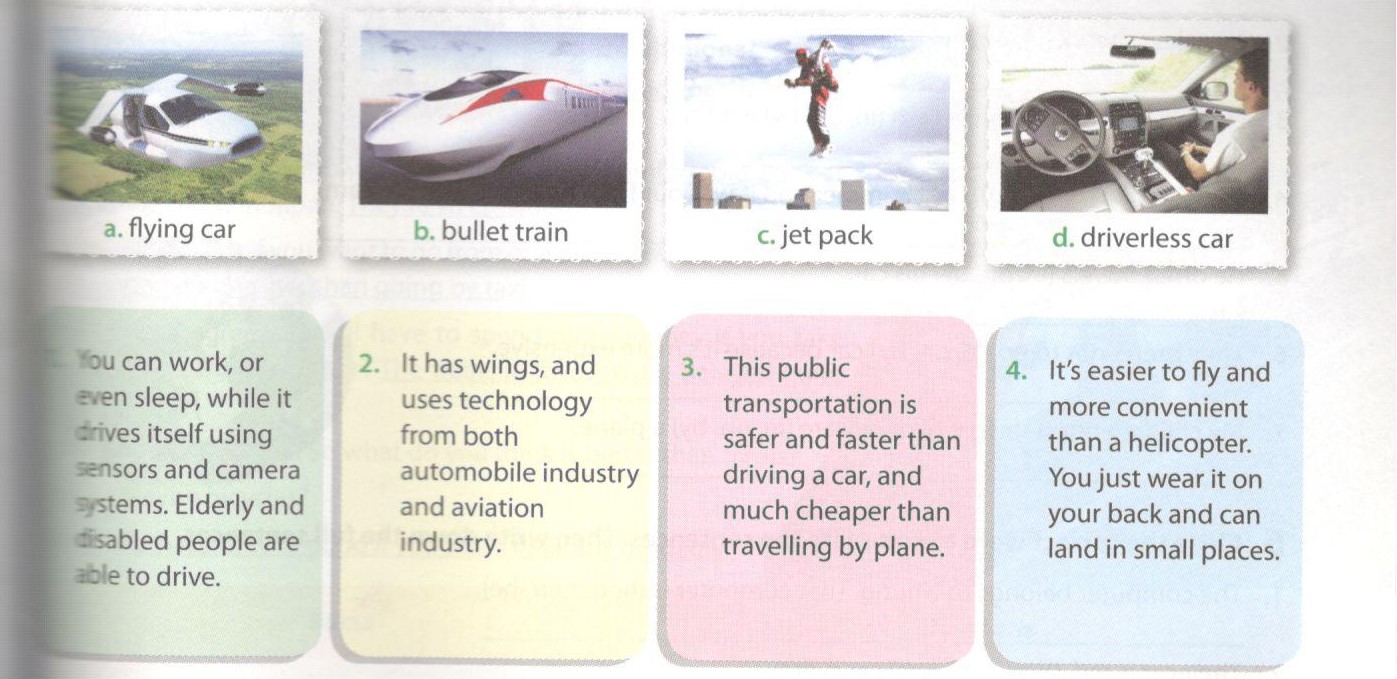
Lời giải chi tiết:
Đáp án:
1. -d. driverless car | 2. | a. flying car | 3. -b. bullet train | 4. -c jet pack |
|
Tạm dịch:
1. Xe hơi tự lái - Bạn có thể làm việc, hoặc thậm chí ngủ, trong lúc nó tự điều khiển sử dụng cảm biến và hệ thống quan sát. Người già và người tàn tật có thể lái.
2. Xe hơi bay - Nó có cánh và sử dụng công nghệ của cả hai ngành công nghệ ô tô và công nghệ hàng không.
3. Tàu cao tốc - Phương tiện công cộng này thì an toàn và nhanh hơn lái một chiếc xe hơi và rẻ hơn di chuyển bằng máy bay.
4. Túi phản lực (jet pack) - Nó dễ điều khiển và tiện lợi hơn trực thăng. Bạn có thể đeo nó sau lưng và hạ cánh ở nơi nhỏ bé.
Bài 2
Task 2. Choose the correct words from the box to fill the gaps.
(Chọn từ đúng từ trong khung để điền vào chỗ trống.)
Eco-friendly | supersonic | Wind-powered | High-speed | driverless | underwater |
Lời giải chi tiết:
1. I think in the future we will be able to go to the Moon in a_____ spaceship that travels faster than the speed of sound.
Đáp án: I think in the future we will be able to go to the Moon in a supersonic spaceship that travels faster than the speed of sound.
Giải thích: supersonic (siêu âm)
Tạm dịch: Tôi nghĩ trong tương lai chứng ta sẽ có thể bay lên mặt trăng bằng phi thuyền siêu thanh mà di chuyển nhanh hơn tốc độ âm thanh.
2. You can read a newspaper while in a______car because it is automated.
Đáp án: You can read a newspaper while in a driveless car because it is automated.
Giải thích: driveless (không cần lái)
Tạm dịch:Bạn có thể đọc báo trong xe hơi tự lái bởi vì nó tự động.
3. Imagine in the future we will take_____________ trains and enjoy watching fish swimming around us when we are travelling.
Đáp án: Imagine in the future we will take underwater trains and enjoy watching fish swimming around us when we are travelling.
Giải thích: underwater (dưới nước)
Tạm dịch:Không thể tin được trong tương lai chúng ta đón tàu ngầm và tận hưởng xem cá bơi xung quanh trong lúc chúng ta đang di chuyển.
4. Solar energy is___________.
Đáp án: Solar energy is eco-friendly
Giải thích: eco-friendly (thân thiện môi trường)
Tạm dịch:Năng lượng mặt trời thì thân thiện với môi trường.
5. ____________ships use wind as their energy for sailing.
Đáp án: Wind-powered ships use wind as their energy for sailing.
Giải thích: WIn-powered (năng lượng gió)
Tạm dịch: Tàu năng lương gió sử dụng gió như năng lượng chạy bằng buồm.
6. 'Bullet train' is a type of _________train that first came from Japan.
Đáp án: 'Bullet train' is a type of high-speed train that first came from Japan.
Giải thích: high-speed (cao tốc)
Tạm dịch: Tàu cao tốc là loại tàu tốc độ cao mà đầu tiên là từ Nhật.
Bài 3
Task 3. Choose the correct option.
(Chọn đáp án đúng.)
Lời giải chi tiết:
1. Look at the photo! You're____
A. driving B. flying C. riding
Đáp án: Look at the photo! You're riding
Giải thích: ride (cưỡi )
Tạm dịch: Nhìn ảnh này! Bạn đang cưỡi ngựa!
2. It's really difficult to__________ a bicycle up the hill.
A. pedal B. drive C. fly
Đáp án: It's really difficult to pedal a bicycle up the hill.
Giải thích: pedal a bicycle (đạp xe)
Tạm dịch:Thật khó để đạp xe lên đồi.
3. You can_____________ easily on the Dead Sea. Why? Because it's so salty!
A. fly B.walk C. float
Đáp án: You can float easily on the Dead Sea. Why? Because it's so salty!
Giải thích: float (nổi)
Tạm dịch:Bạn có thể dễ nổi ở biển chết. Tại sao? Vì nó khá mặn.
4. She is a frequent customer of that airline. She has to_____________ every month for work.
A. drive B. fly C. ride
Đáp án: She is a frequent customer of that airline. She has to fly every month for work.
Giải thích: fly (bay)
Tạm dịch: Cô ta là khách hàng thường xuyên của công ty hàng không đó. Cô ta đã bay hàng tháng vì công việc.
5. Will you_____________ a taxi or a train?
A. fly B. walk C. take
Đáp án: Will you take a taxi or a train?
Giải thích: take a taxi (đón taxi)
Tạm dịch: Bạn sẽ đón taxi hay tàu?
6. He______________in a white sport car.
A. walks B. drives C. takes
Đáp án: He drives in a white sport car.
Giải thích: drive (lái xe)
Tạm dịch: Anh ta lái xe hơi thể thao màu trắng.
Bài 4
Lời giải chi tiết:
Đáp án: She came to the stadium by bus.
Giải thích: Di chuyển bằng phương tiện gì ==> sử dụng by
Tạm dịch: Cô ấy đến bảo tàng bằng xe buýt
Đáp án: They go to work by train.
Giải thích: Di chuyển bằng phương tiện gì ==> sử dụng by
Tạm dịch:Họ đi làm bằng tàu.
Đáp án: I usually read books while I am on a train.
Giải thích: on (trên)
Tạm dịch:Tôi thường độc báo những lúc ở trên tàu.
Đáp án: We went to Gothenburg last summer and it was our first time on a tram.
Giải thích: on (trên)
Tạm dịch:Chúng tôi đã đi Gothenburg vào mùa hè năm ngoái và nó là lần đầu tiên của chúng tôi đi tàu
Đáp án: He often travels in his car.
Giải thích: travel in (di chuyển bằng)
Tạm dịch: Anh ấy thường di chuyển bằng xe hơi.
Đáp án: They prefer not to go by car because it's more expensive.
Giải thích: Di chuyển bằng phương tiện gì ==> sử dụng by
Tạm dịch: Anh ta không thích đi bằng xe hơi bởi vì nó khá đắt.
Đáp án: My children often sleep while they are on a plane.
Giải thích: on (trên)
Tạm dịch: Con chúng tôi thường ngủ trong lúc chúng trên máy bay.
Bài 5
Lời giải chi tiết:
1. The computer belongs to Nhung. That computer is (hers/her/she).
Đáp án: The computer belongs to Nhung. That computer is hers
Giải thích: đằng sau không có danh từ nên ta sử dụng đại từ sở hữu ==> hers
Tạm dịch: Máy tính thuộc quyền sở hữu của Nhung. Đó là máy tính của cô ấy.
2. Their car is red. (We/Our/Ours) car is grey.
Đáp án: Their car is red. our car is grey.
Giải thích: Đằng sau có danh từ ==> cần 1 tính từ sở hữu
Tạm dịch:Xe hơi của họ màu đỏ. Xe hơi của chúng tôi màu xám.
3. The books are all (me/mine/my).
Đáp án: The books are all mine.
Giải thích: đằng sau không có danh từ nên ta sử dụng đại từ sở hữu ==> mine
Tạm dịch:Những quyển sách là của chúng tôi.
4. What happened to him? He has broken (him/his/he) arm.
Đáp án: What happened to him? He has broken his arm.
Giải thích: Đằng sau có danh từ ==> cần 1 tính từ sở hữu
Tạm dịch: Chuyện gì xảy ra với anh ấy? Anh ta bị gãy tay.
5. (Mine/My/Me) keys are here on the table. Where are (your/yours/us)?
Đáp án: My keys are here on the table. Where are yours?
Giải thích: Đằng sau có danh từ ==> cần 1 tính từ sở hữu (my)
đằng sau không có danh từ nên ta sử dụng đại từ sở hữu ==> yours
Tạm dịch: Những chìa khóa của tôi ở đây nằm trên bàn. Những cái của bạn ở đâu?
6. Is this chair (you/your/yours)?
Đáp án: Is this chair yours?
Giải thích: đằng sau không có danh từ nên ta sử dụng đại từ sở hữu ==> yours
Tạm dịch: Ghế này của bạn phải không?
Bài 6
Task 6. Put the words in brackets in correct forms. Pay attention to the positive/negative form.
(Cho dạng đúng của động từ trong ngoặc. Chú ý vào các dạng chủ động/bị động của động từ.)
I think in the future cities (1. be)__________________ more crowded and the traffic (2.get)______________________________worse. People (3. use)_____________ more cars and air pollution (4.become)_________a big problem. There (5. be)__________enough space for trees and lakes and buildings (6. rise)_____________ everywhere. Perhaps less people (7. ride)_____their bicycles. The price offuel (8.increase)___________ . Life (9. be)_____________ easy at all!
Lời giải chi tiết:
Key - Đáp án:
1. will be
Đáp án: I think in the future cities will be more crowded
Giải thích: In the future, diễn tả hành động sẽ làm gì ==> will
2. will get
Đáp án: the traffic will get worse.
Giải thích: diễn tả hành động sẽ làm gì ==> will
get worse (trở nên tồi tệ)
3. will use
Đáp án: People will use more cars
Giải thích: diễn tả hành động sẽ làm gì ==> will
use (sử dụng)
4. will become
Đáp án: air pollution will become a big problem.
Giải thích: diễn tả hành động sẽ làm gì ==> will
become (trở nên)
5. wont be
Đáp án: There won't be enough space for trees and lakes
Giải thích: diễn tả việc không xảy ra trong tương lai ==> won't
6. will rise
Đáp án: buildings will rise everywhere.
Giải thích: diễn tả hành động sẽ làm gì ==> will
rise (mọc lên)
7. will ride
Đáp án: Perhaps less people will ride their bicycles.
Giải thích: diễn tả hành động sẽ làm gì ==> will
ride bikes (đạp xe)
8. will increase
Đáp án: The price offuel will increase .
Giải thích: diễn tả hành động sẽ làm gì ==> will
increase (tăng)
9. won't be
Đáp án: Life won't be easy at all!
Giải thích: diễn tả việc không xảy ra trong tương lai ==> won't
Tạm dịch:
Tôi nghĩ các thành phố trong tương lai sẽ đông hơn và giao thông tệ hơn. Con người sẽ sử dụng nhiều xe hơi hơn và ô nhiễm không khí sẽ trở thành vấn đề lớn. Sẽ không đủ không gian cho cây cối, hồ và cao ốc sẽ mọc lên khắp nơi. Có lẽ ít người sẽ đi những chiếc xe đạp của họ. Giá nhiên liệu sẽ tăng. Cuộc sống sẽ không dễ cho tất cả mọi người!
C. SPEAKING
Task 1a. Read the conversation, look at the underlined statements. Which statements are facts? Which ones are opinions?
Đọc đoạn văn sau, nhìn vào các câu được gạch chân. Câu nào là thật, câu nào là ý tưởng?
Anna: I think rail travel is the best transport method for the future. What do you think Mai?
Mai: Well... I don't know. It's perhaps quite uncomfortable. Look at the trains in Japan. They're so crowded.
Anna: But it's fast if you want to go from one place to another in a city. And it's cheaper than going by taxi.
Mai: Yes, I agree you will have to spend more money if you take a taxi. But is it faster? The trains in Sweden are delaved quite often.
Anna: Yes, that's right. So what do you think is better than trains?
Mai: Maybe bicycles?
Anna: Perhaps they're good if you don't have any luggage.
Facts | Opinions |
|
|
b. Look at the Opinions Box. Do you agree with these opinions? Say why you do or why you don't.
Nhìn vào cột ý tưởng. Bạn có đồng ý với các ý tưởng này không? Tại sao có và tại sao không?
Lời giải chi tiết:
a)
Key - Đáp án:
Facts | Opinions |
They're so crowded. And it's cheaper than going by taxi. The trains in Sweden are delayed quite often.
| I think rail travel is the best transport method for the future. It's perhaps quite uncomfortable. Perhaps they’re good if you don’t have any luggage. |
b)
Key - Đáp án:
| Agree | Disagree |
Rail travel is the best transport method for the future. | It's cheap and can help reduce pollution. | Bicycle are even cheaper and more eco-friendly. |
Travelling by train is quite uncomfortable. | It's crowded and there can be delayed. | You can work or even take a nap on a train. |
Travelling by bicycle is good if you don't have any luggage. | If you have suitcases you should go by car, or by train. | You can just put your things in a backpack and wear it. |
Bài 2
Task 2. This is Huong and some information about herself. Can you predict her future? Choose one option and say your predictions. Explain your choice.
Đây là Hương và một vài thông tin về cô ấy. Bạn có thể dự đoán tương lai của cô ấy không? Chọn một đáp án và nói lên dự đoán của bạn, giải thích.
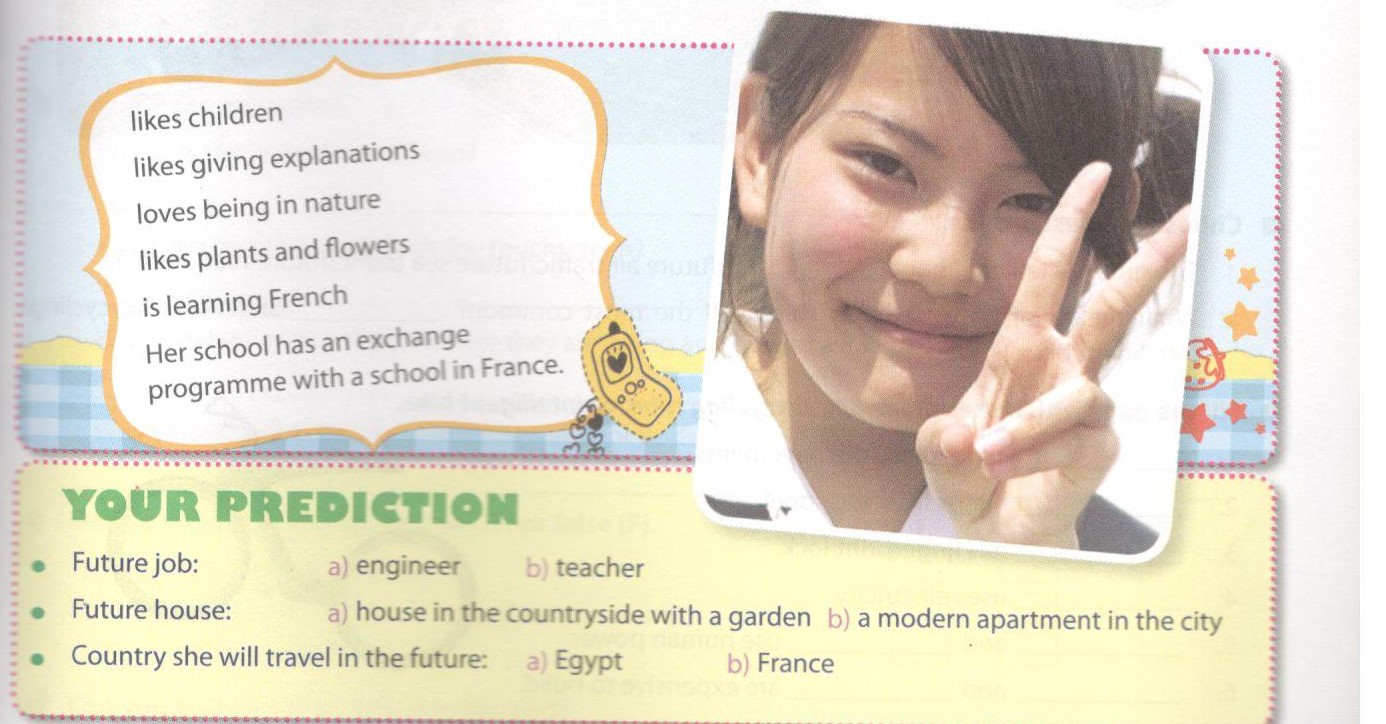
Lời giải chi tiết:
Đáp án:
Huong will become a teacher because she Boesctifldpen and Hoes giving explanations.
She will live in a house in the countryside with a ggden because she Bees plants and flowers and she loves being in nature.
She will travel to France in the future because her school has an exchange programme with a school in France and she can speak French.
D. READING
Task 1. Read the conversation and do the following tasks.
Đọc đoạn hội thoại sau và làm các nhiệm vụ dưới đây.
Mai: ... That was about future air travelling. Now we'll talk about future road transport with slidewalks, skycycling, and bicycles.
Veronica: Slidewalks are similar to moving walkways in airports. When slidewalks replace our pavements they'll help us move faster.
Phuc: Skycycling tubes hang from monorails and you can cycle while watching the city from above.
Veronica: Intelligent bikes have foldable roof for rainy weather. They'll never be stolen because they use fingerprint lock.
Mai: All of them are environmentally friendly. Slidewalks use electricity, while skycycling and intelligent bikes use human power. But in our opinion intelligent bikes will be the most common, because building slidewalks and skycycling system can be expensive.
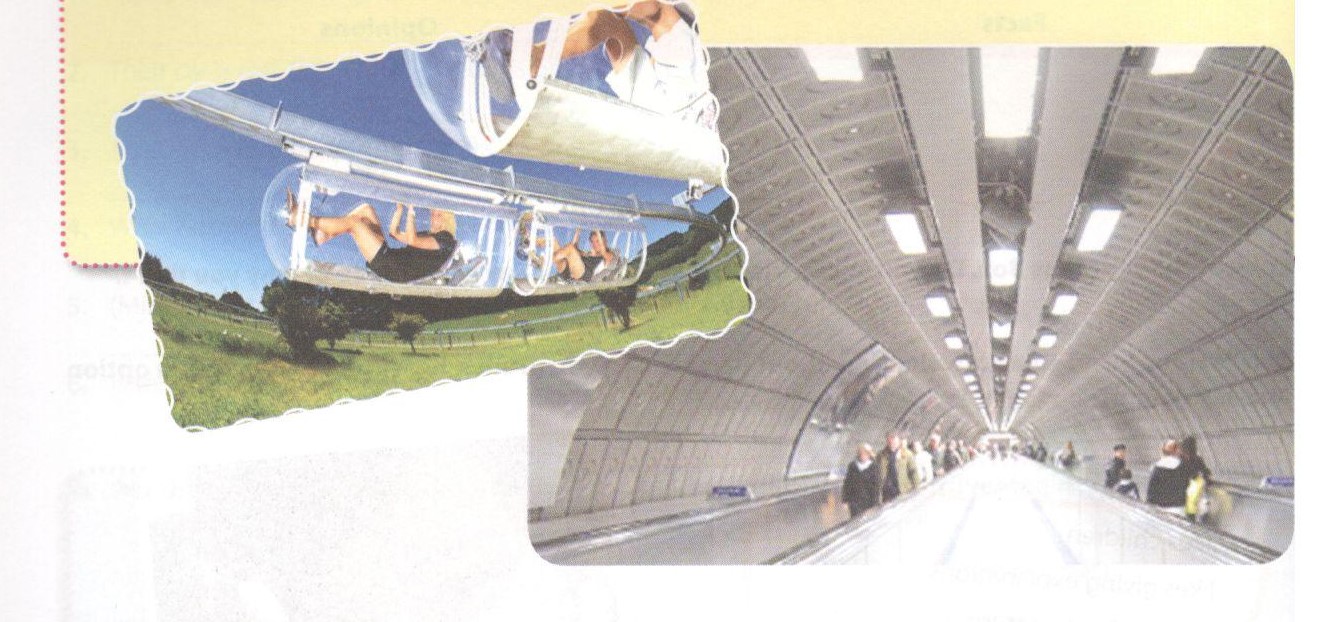
a. Choose the best answer.
b. Fill the gaps with either slidewalk, skycycling tube, or intelligent bike.
Lời giải chi tiết:
1. The group is talking about__________(future air traffic/future sea traffic/future road traffic).
Đáp án: The group is talking about future road traffic
2. What means of transport they think will the most common?______(Slidewalks/Skycyclii/Intelligent bikes).
Đáp án: What means of transport they think will the most common? intelligent bikes
b)
1. _____________ can replace the pavements.
Đáp án:Slidewalks can replace the pavements.
2. _____________hangs from monorail.
Đáp án:Skycycling tube hangs from monorail.
3. _____________ has fingerprint lock.
Đáp án:An intelligent bike has fingerprint lock.
4. _____________ uses electricity.
Đáp án:Slidewalk uses electricity.
5. _____________and______________ use human power.
Đáp án:Skycycling/intelligent bikes use human power.
6. _____________and______________ are expensive to build.
Đáp án: Slidewalk/skycycling are expensive to build.
Bài 2
Task 2. Read the text and answer the question, then do the following tasks.
URBAN TRANSPORT PODS
The people living in Milton Keynes, a town about 70 kilometres northwest of London, have been introduced to a new transport experience when they use'pods' to travel on certain routes.
The pods are a kind of driverless cars which travel at 19km/h and are able to transport two people and their luggage. There is a touchscreen in the windshield of the pods where passengers select their terminal. During the trip they can also read the news, check e-mails or play video games on the screen. Powered by electric motors, the pods have ultrasonic sensors and a GPS system that help themselves know where they are go?ng and how to avoid obstacles along the way. People can use a smartphone app to hail a pod in :ne street.
Do you think this way of transport will appear in cities in Viet Nam soon?
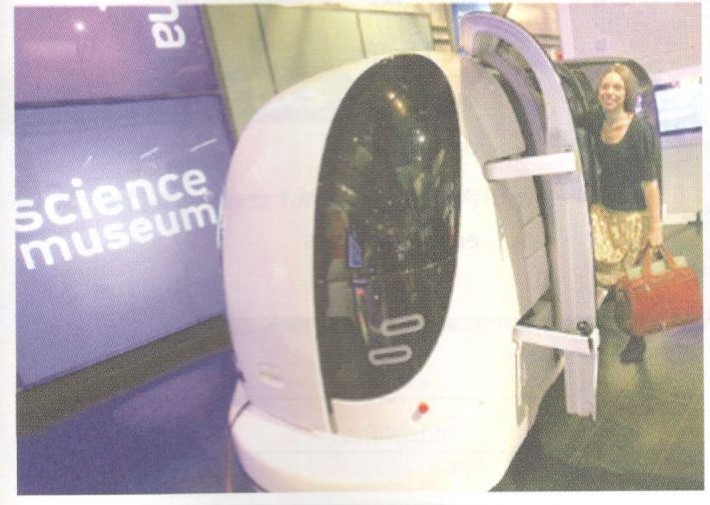
a. Find in the text words that have similar meanings with these words/phrases.
Tìm từ đồng nghĩa với từ và cụm từ dưới đây.
b. Answer the questions.
Trả lời các câu hỏi sau.
c. Decide if the staments are true (T) or false (F).
Các câu dưới đây đúng (T) hay sai (F).
| T | F |
1. Pods are a type of robot car |
|
|
2. You can use pods to travel to any place you want. |
|
|
3. Pods are eco-friendly. |
|
|
d. Can you answer the question in the text?
Bạn có thể trả lời câu hỏi trong đoạn văn trên không?
Lời giải chi tiết:
a)
1. pathways between two particular places
Đáp án: routes
2. destination
Đáp án: terminal
3. travellers
Đáp án: passengers
4. blocks
Đáp án: obstacles
5. get
Đáp án: hail
b)
1. Where is the project introduced?
Đáp án:In Milton Keynes, a town about 70 kilometres northwest of London.
2. What can passengers do with the touchscreen?
Đáp án: They can select their terminal, read the news, check e-mails or play video games.
3. What enables pods to -tere they are going and how to avoid obstacles?
Đáp án:The ultrasonic sensors and the GPS system.
4. Why should you need the smartphone app for pods?
Đáp án:People can use a smartphone app to hail a pod in the street.
c)
1. T (The pods are a type of driverless cars.)
2. F (You can only use the pod to travel on certain routes.)
3. T (The pods are powered by electric motors.)
E. WRITING
Task 1. Write five sentences to describe the picture about cities and transport in 2100. You may use suggestions if needed.
Viết năm câu để mô tả thành phố và các phương tiện giao thông trong năm 2100. Có thể sử dụng các gợi ý nếu cần.
Lời giải chi tiết:
Đáp án:
In the future people will use flying cars and supersonic buses. On the ground there will be no car traffic. You will just walk and there will be places to land your flying vehicles. There will be many open spaces where we enjoy beautiful fountains and green trees. Buildings will be constructed with solar panels. Most of our engines will be solar-powered.
Tạm dịch:
Trong tương lai mọi người sẽ sử dụng ô tô bay và xe buýt siêu thanh. Trên mặt đất sẽ không có xe lưu thông. Bạn sẽ chỉ cần đi bộ và sẽ có nơi hạ cánh phương tiện bay của bạn. Sẽ có nhiều không gian mở, nơi chúng ta thưởng thức những đài phun nước và cây xanh tuyệt đẹp. Các tòa nhà sẽ được xây dựng với các tấm pin mặt trời. Hầu hết các động cơ của chúng tôi sẽ được cung cấp năng lượng mặt trời.
Bài 2
Task 2. How do you go to school every day? On foot, by bicycle, by bus, by boat, or in a car? What are things you like about it? What are the things you don't like about it? Do you want to make your travelling better? Write at least three ideas in these boxes and present them to the class if possible.
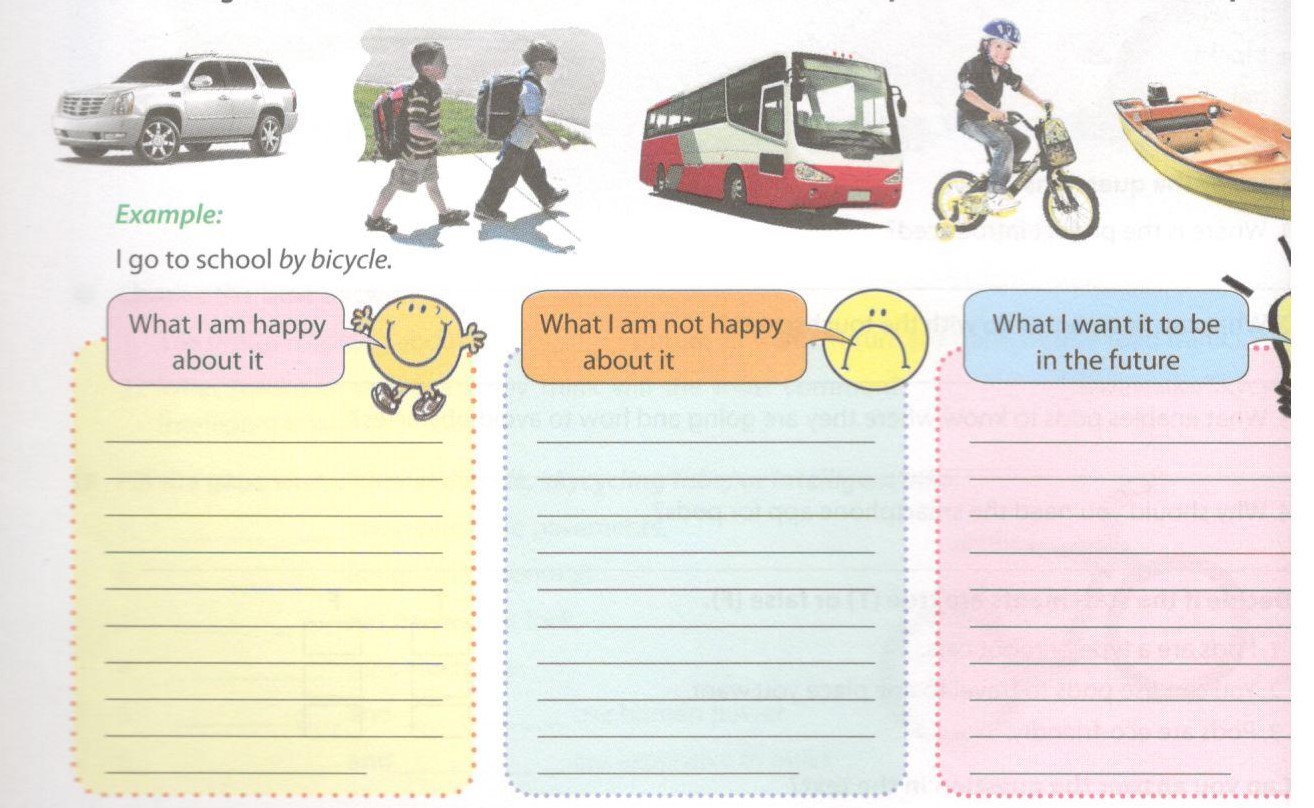
Lời giải chi tiết:
Tạm dịch:
Hằng ngày bạn đến trường bằng phương tiện gì? Đi bộ, xe đạp, xe bus, tàu hay ô tô? Bạn cảm nhận thế nào về các phương tiện đó? Bạn thích phương tiện đó ở điểm gì? Bạn có muốn một phương tiện tốt hơn? Viết ít nhất 3 ý trong số trên và nói trước lớp nếu có thể.













0 Nhận xét